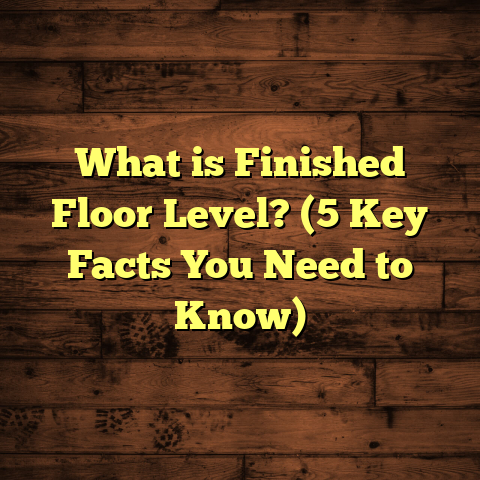What is the Average Price to Install Vinyl Plank Flooring? (5 Key Factors to Consider)
When I first started installing vinyl plank flooring, I quickly realized one thing: people want to know exactly what they’re getting into cost-wise. It’s one of the most common questions I get from clients. But the truth is, there isn’t a simple answer because vinyl plank flooring costs vary widely depending on many factors.
If you’ve ever wondered about the average price to install vinyl plank flooring and what affects that price, you’re not alone. Over the years, I’ve helped hundreds of homeowners and contractors understand exactly how much they should budget for their projects. I’ll share what I’ve learned, including my own experiences, real pricing data, and tips to keep costs manageable without sacrificing quality.
What Is Vinyl Plank Flooring?
Let’s start with the basics. Vinyl plank flooring is a type of synthetic flooring designed to mimic the look and feel of natural hardwood floors. It is made from multiple layers of vinyl with a photographic film layer that replicates wood grain patterns, colors, and textures. The top layer is a clear wear layer that protects against scratches and stains.
Why choose vinyl plank flooring? Well, it combines style, durability, and affordability in a way few other floorings can. You get the warm look of wood but with benefits like water resistance and easier maintenance.
Here’s a quick breakdown of its composition:
- Wear Layer: This is the protective top coat that determines durability.
- Design Layer: The photographic film that gives the wood look.
- Core Layer: Provides stability; can be rigid (WPC or SPC) or flexible.
- Backing Layer: Adds support and moisture barrier.
There are different types of vinyl plank flooring:
- Luxury Vinyl Plank (LVP): Thicker with enhanced features like waterproof cores.
- Standard Vinyl Planks: More affordable but less durable.
Why Vinyl Plank Flooring Is So Popular
From my experience, vinyl plank flooring has become a go-to choice for many homeowners for several reasons:
- Water Resistance: Unlike real wood, vinyl planks hold up great in wet areas like kitchens and bathrooms.
- Affordability: It’s often much cheaper than hardwood or tile.
- Ease of Installation: Many vinyl planks use a click-lock system, making DIY possible.
- Low Maintenance: Simple cleaning routines are enough.
- Variety: Tons of styles and finishes to match any décor.
When I started working with vinyl plank flooring over a decade ago, it wasn’t as popular or advanced as it is now. The quality has improved tremendously with thicker wear layers and realistic textures that fool even hardwood enthusiasts.
What Influences the Price of Vinyl Plank Flooring?
The biggest reason why clients get confused about cost is because “vinyl plank flooring” means many different things depending on quality, location, and installation complexity. Here are the five key factors I always explain to customers:
1. Material Quality and Type
Every homeowner wants floors that look great and last long without breaking the bank. But there’s a huge price difference between entry-level vinyl planks and high-end luxury options.
Material Cost Breakdown
From my projects, here’s how material prices usually stack up per square foot:
| Grade | Cost Range (Material Only) |
|---|---|
| Basic Entry-Level | $1.00 – $2.00 |
| Mid-Range | $2.00 – $4.00 |
| Luxury Vinyl Plank | $4.00 – $7.00 |
What’s the difference? Entry-level planks often have thinner wear layers (around 8 mil or less), less realistic textures, and lower core stability. These are good for low-traffic areas or temporary solutions.
Mid-range options improve on thickness (12-15 mil wear layers), offer better texture embossing, and sometimes include enhanced waterproof cores.
Luxury vinyl planks feature thick wear layers (20 mil or more), wide plank sizes, authentic wood embossing, rigid cores (SPC/WPC), and often come from reputable brands with improved warranties.
My Personal Take on Material Quality
I remember one project where a client wanted the cheapest option possible—$1 per sq.ft. material cost. We installed it in a rental property’s living room with moderate foot traffic. Within two years, the floor showed signs of wear: scratches, dents, and peeling edges.
Contrast that with another project using a $6 per sq.ft. luxury vinyl plank in a family kitchen where kids and pets run around all day. That floor still looks brand new after 5 years.
The upfront savings may seem attractive but think about long-term durability and appearance.
2. Labor Costs and Installation Complexity
Labor is often as much or more than materials in flooring projects. The price depends heavily on who installs it and how complicated the job is.
Typical labor rates range from $1.50 to $4.00 per square foot based on:
- Installer Experience: Certified pros charge more but deliver higher quality.
- Room Size: Larger rooms generally reduce per sq.ft. cost.
- Room Layout: Odd shapes, stairs, or lots of corners add time.
- Subfloor Condition: Uneven or damaged floors require prep work.
- Type of Installation: Floating click-lock floors are quicker; glue-down takes longer.
What Makes Installation Challenging?
I once worked on an older Victorian home where the floors were uneven by over half an inch in places. We had to spend two days leveling the subfloor before laying vinyl planks, which increased labor hours — costing the client nearly 30% more than a standard install.
In contrast, a straightforward installation in a new build took only one day for 600 sq.ft., keeping labor costs low.
DIY or Hire a Pro?
Some homeowners consider DIY installation to save money since many vinyl planks snap together without glue. If you’re handy and patient, DIY can save around $2 per sq.ft.
But mistakes like improper subfloor prep or misaligned planks can lead to costly repairs down the line.
3. Subfloor Preparation
This part often flies under the radar until installers show up and find issues.
Vinyl planks require a clean, flat surface for proper installation:
- Minor imperfections can cause gaps or creaking.
- Moisture problems must be addressed before laying any floor.
- Sometimes removal of old flooring is necessary.
How Much Does Prep Cost?
From my experience, subfloor prep adds $0.50 to $2 per sq.ft., depending on what’s needed:
- Cleaning & minor leveling: Low cost.
- Repairing cracks or holes: Moderate cost.
- Complete leveling or moisture barriers: Higher cost.
In one case, I helped a client install vinyl planks over existing tile but had to grind down several high spots and fill grout lines to create a smooth surface—this took extra time but was critical for success.
4. Where You Live Matters
Geography plays a surprisingly big role in pricing—even for identical materials.
Urban centers with high labor costs command higher prices.
For example:
- New York City labor rates often exceed $4 per sq.ft.
- Midwest towns average between $1.50-$3 per sq.ft.
- Rural areas might be lower but come with fewer contractor options.
Material costs also fluctuate based on shipping fees and availability.
I’ve worked in multiple states; knowing local market rates helps me give realistic estimates upfront instead of guesswork.
5. Additional Expenses: Removal & Waste Factors
Many people forget about these until after budgeting:
- Old Flooring Removal: Removing carpet or tile costs $1-$3 per sq.ft.
- Waste Factor: I always recommend ordering 10% extra material for cuts, mistakes, or pattern matching needs.
- Accessories: Moldings, trims, transition pieces usually add to final costs.
These extras can add hundreds of dollars depending on floor size.
How I Use Tools Like FloorTally to Save Time and Improve Accuracy
Over years managing multiple projects simultaneously, I found estimating by hand tedious and prone to errors. That’s when I started using FloorTally — an online tool that streamlines cost calculations by incorporating local material prices and labor rates automatically.
It lets me input room dimensions, pick materials from a huge catalog, adjust waste percentages, and instantly get detailed cost breakdowns tailored to each project location.
The best part? It saves me hours manually hunting for prices or guessing labor costs based on zip codes.
Using FloorTally has improved my quoting accuracy drastically — clients appreciate transparent budgets without surprises later on.
Real Case Studies From My Work
Case Study 1: Small Urban Apartment Renovation
- Location: Chicago
- Size: 500 sq.ft.
- Material: Mid-range vinyl plank ($3/sq.ft.)
- Labor: Professional installer at $2.50/sq.ft.
- Subfloor prep: Minimal
- Old flooring: Carpet removal included
Total Installed Cost: About $5.75 per sq.ft.
The client wanted durable floors but was on a budget. We chose mid-grade vinyl with a 12-mil wear layer sufficient for apartment life. The installation took two days including carpet removal.
Case Study 2: Family Kitchen Remodel in California
- Location: San Diego
- Size: 300 sq.ft.
- Material: Luxury vinyl plank ($6/sq.ft.)
- Labor: Experienced installer at $3.50/sq.ft.
- Subfloor prep: Moderate leveling required
- Old flooring: Tile removal included
Total Installed Cost: Approximately $9.50 per sq.ft.
This project demanded high-end finishes due to family lifestyle with kids and pets prone to spills. The premium luxury planks combined with subfloor prep ensured long-term performance despite higher initial cost.
Case Study 3: Basement Update in Northeast Town
- Location: Boston suburb
- Size: 700 sq.ft.
- Material: Entry-level vinyl planks ($1.50/sq.ft.)
- Labor: Local contractor at $2/sq.ft.
- Subfloor prep: Moisture barrier added
- Old flooring: None
Total Installed Cost: Around $4 per sq.ft.
Basement floors required moisture mitigation so we installed a vapor barrier beneath the planks. Client wanted an affordable upgrade for extra living space; entry-level materials balanced budget constraints.
Tips From My Toolbox for Choosing Vinyl Plank Flooring Wisely
Here are some things I always share with people based on what I’ve seen working on countless projects:
Don’t Go Too Cheap on Wear Layer
A thick wear layer (12 mil or more) protects against scratches and wear longer—especially important in busy households or commercial spaces.
Know Your Room’s Purpose
Not all rooms need luxury-grade planks. Low traffic areas like guest rooms can use more affordable options without problems.
Prep Your Subfloor Thoroughly
Simple fixes like cleaning debris or minor sanding can prevent costly installation mistakes later.
Order Extra Material Early
10% more material saves headaches during installation — trust me!
Get Multiple Quotes from Installers
Ask for detailed estimates including prep work so you’re comparing apples to apples.
Consider DIY Only If You’re Confident
Vinyl planks are easier than hardwood but still require precision for best results.
Common Questions I Get About Vinyl Plank Flooring Pricing
Q: Can I install vinyl plank flooring over existing hardwood?
A: Usually yes—as long as the hardwood is flat and solid without damage. Sometimes sanding or leveling is needed first.
Q: How long does installation take?
A: For average rooms (~500 sq.ft.), professional installers typically finish in 1–3 days depending on prep work complexity.
Q: Will my floor feel cold?
A: Yes — vinyl is thinner than hardwood so it can feel cooler underfoot unless paired with underlayment or radiant heating systems.
Wrapping It Up With Some Numbers You Can Trust
After working with hundreds of projects across different states and budgets, here’s my best estimate for average total installed price including materials and labor:
| Project Type | Average Cost Per Sq.Ft. Installed |
|---|---|
| Budget/Entry-Level Projects | $3 – $5 |
| Mid-Range Residential Jobs | $5 – $7 |
| High-End/Luxury Installations | $7 – $10+ |
Remember to factor in subfloor prep costs (0.50-$2 sq.ft.) and any removal expenses if applicable.
If you’re planning your next flooring project, understanding these factors will help you make smart choices that balance budget with durability and style.
And if you want help breaking down estimates by room size or location — don’t hesitate to use tools like FloorTally that I’ve found so helpful in my own work.
Feel free to reach out if you want personalized advice based on your home’s specifics!
Would you like me to go deeper into installation techniques or brand recommendations next? Or perhaps share tips on maintaining your new vinyl plank floor? Just let me know!





